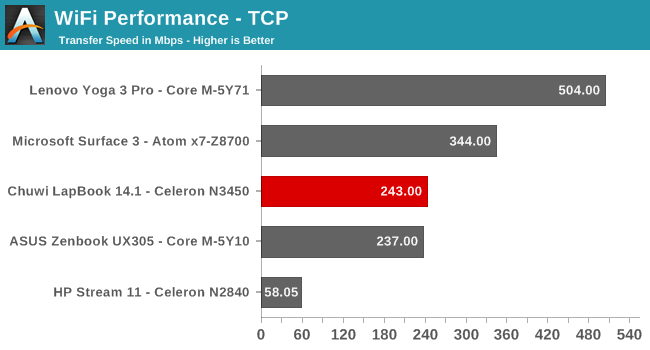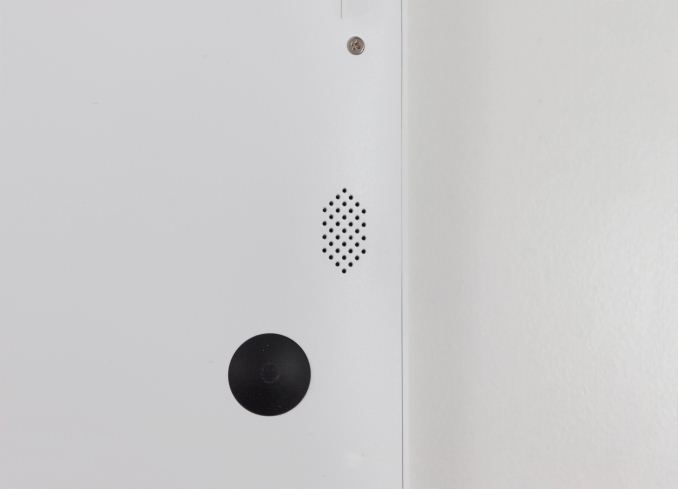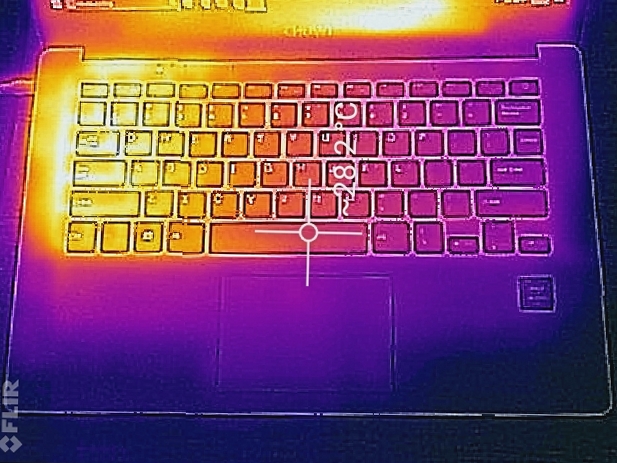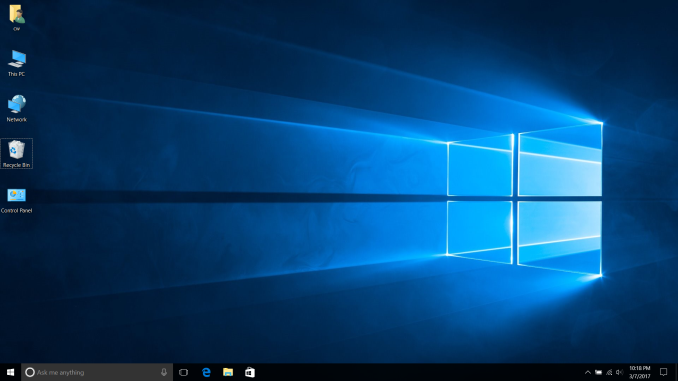The Chuwi LapBook 14.1 Review: Redefining Affordable
by Brett Howse on March 10, 2017 8:00 AM ESTWireless
Chuwi has surprised me yet again. Instead of using a bargain basement wireless NIC, they have gone with the dependable Intel Wireless-AC 3165 solution. This isn’t the latest and greatest Intel wireless NIC, but it is at least an 802.11ac model which includes built-in Bluetooth. The big change over this and the Intel Wireless-AC 7265, which was also a “Stone Peak” NIC, is that the 3265 is 1x1 only, meaning it has a peak connection speed of 433 Mbps, compared to the 867 MHz of the faster 2x2 solution. There is a newer version of this card, the 3168, which would likely lower power consumption, but with the fact that a 1x1 wireless solution was almost guaranteed, the 3265 is a good choice.

Although it’s not 100% fair to compare the ASUS UX305 here, it shipped with a 2x2 solution, but with the Intel Dual Band Wireless-N 7265, which was the same generation of Wireless NIC, but with only 802.11n support. The result is that, even though the Chuwi is a 1x1 solution, it basically outperforms the 2x2 802.11n solution in the UX305. Compared to the Realtek 1x1 802.11n NIC in the HP Stream 11, the Intel 3265 walks all over it, especially since the HP was 2.4 GHz only. Anything that is 802.11ac requires 5 GHz, which has less range, but far more bandwidth. Despite the 1x1 wireless, the Chuwi has a very respectable wireless solution. There had to be cuts somewhere. If anyone is still running an 802.11n router, take this as a good set of data to support an upgrade.
Audio
The LapBook has two speakers on the underside of the notebook, which is often the case on smaller laptops where space is at a premium, but that can greatly vary the sound output depending on what surface the laptop is on, so it is never the best way to proceed.
The LapBook does get surprisingly loud, with 86 dB(A) measured at maximum volume with the SPL meter an inch over the trackpad, but the tone of this notebook is terrible. There is almost no low end bass at all, so music has almost no range at all. This is one of the worst sounding speakers I’ve ever seen in a notebook, but then again there are plenty of headphones that cost more than this entire machine, so I suppose you have to cut it some slack.
Thermals
Generally, in this section, we’d look at the performance and ensure the cooling solution is adequate to keep the system functioning at full performance, and while that has been tested, there’s really not much to say. Since the laptop is fanless, there is no audible cooling solution, which is certainly a nice benefit, and the CPU never got over 80°C at 100% load for several hours of operation. Despite this, the laptop itself barely even got warm to the touch, with just a bit of a warm spot on the bottom where the CPU is. Doing research for this article, I did come across a couple of complaints about this laptop overheating and shutting down. That’s clearly not a good thing, but the device we received showed no signs of that. I think it’s something the company should take seriously, and a small bit of effort on the engineering side would help a lot.
Thanks to our friends at FLIR, we can use their FLIR One thermal imaging camera to get a look at the heat output on this notebook. This photo was after 90 minutes of 100% load, and the lapotop temperatures were very low. There was a bit of heat, up to around 34-35°C, right above the CPU, but the keys never felt hot to the touch.
Software
Long have we lived in an age where laptops come loaded down with plenty of unnecessary software. Sometimes it’s somewhat useful, such as system tools or software for fan speed, or what have you, but often it’s trial software, or just unnecessary utilities. I’m very happy to see that Chuwi has proven you can offer a low-cost notebook, without all of the software they would normally get paid to install for you.
The Chuwi LapBook 14.1 came with clean Windows 10. There was no additional software installed. In fact, other than them adding a few icons to the desktop for This PC, Control Panel, and Documents, it is as close to a pure Windows 10 install as any laptop I have used, other than Surface devices. Nice job Chuwi.














75 Comments
View All Comments
Mikuni - Friday, March 10, 2017 - link
Pointless, probably $400 in Europe.vladx - Saturday, March 11, 2017 - link
It's around 300 euros here in Europe.YoloPascual - Saturday, March 11, 2017 - link
Given the perf/watt of zen architecture, can we expect AMD to release ryzen mobile chips at this tdp?hojnikb - Saturday, March 11, 2017 - link
There is a chance, but not as 4 core parts. Maybe if they do a special 2C4T part with smaller gpu just for cheap and low tdp devices. Sorta like stoney ridge.YoloPascual - Saturday, March 11, 2017 - link
This is what I am thinking too. AMD seems to emphasize "scalability" of zen architecture. I wonder if they can scale downwards too.wumpus - Saturday, March 11, 2017 - link
Not directly. 4C4T 2GHz @ 6W sounds more like Bobcat/Jaguar in the AMD world (what's in PS4/XBox1). Half a raven ridge would still suck twice the power (at max, probably doing more than twice as much).On the other end, this whole architecture is a dead end. No idea how long Intel will produce it (or even update the GPU, they aren't updating the CPU). I doubt AMD is all that interested in updating the "cat" architecture either (although obviously they will continue to produce PS4/Xbox1 SOCs). Given time, "1/2 raven ridge" will probably become pretty competive for this type of thing, assuming you don't go straight to ARM chromebook/android/Linux on ARM/Win10ARM [Microsoft keeps insisting that last bit *is* a thing, but haven't managed to convince anyone else].
DanNeely - Saturday, March 11, 2017 - link
Maybe, but their 8/16 desktop parts being at the same TDP as Intels 4/8 ones suggests that their core design power is significantly lower than Intels, and the last few generations of their architecture can scale down to 4-6W from 90 at a 50% core count so AMD being able to do the same with Ryzen wouldn't surprise me. OTOH a 2/4 core chip at that level seems a lot more likely as a potential atom challenger. OTOH with the first Ryzen laptop parts not due until the second half of this year (and probably the 4th quarter or they'd've said Q3 instead of H2) I wouldn't be surprised if the first chip in this power class isn't available for a full year.fanofanand - Monday, March 13, 2017 - link
Ryzen 8/16 being lower than Intel 4/8 isn't as big a deal as it's being made of. The intel parts being used in that comparison all have a gigantic iGPU that takes up half the die space. This is the same issue as "Ryzen's chip is smaller than Core" well yeah because there is no iGPU! If you were to compare the non-iGPU portion of the Core die, you will see that it's smaller than the Ryzen die, and likely the same would hold true with power consumption. All that said, AMD will definitely have low power cores and they will most likely be on the Ryzen architecture. Way too early to even guess at performance but all signs point to it being a competitive chip.OnthroX - Saturday, March 11, 2017 - link
$230 at GearBest with a EU Plug (vs $270 at Amazon)http://www.gearbest.com/laptops/pp_602696.html
I added DHL Shipping for $5 -- order came out to a total of $235.23
My first time shopping at GearBest but I hear they are okay.
Diji1 - Saturday, March 11, 2017 - link
Good to see Ars covering a Chuwi product.The "Chinese manufacturers" phone, tablet and ultra/laptop recieves relatively little coverage in English speaking media which should change IMO.
It would be great if you looked at Cube, another Chinese brand on tablets andultrabooks.